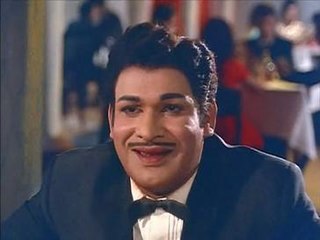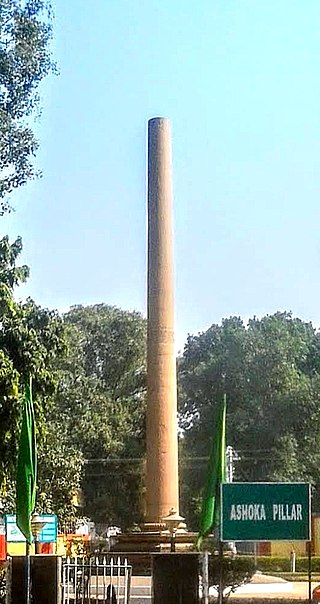Ashokan or Asokan may refer to:
Contents
- Something related to Ashoka (304–232 BCE), Indian emperor of the Mauryan Empire
Ashokan or Asokan may refer to:

Ashoka, and popularly known as Ashoka the Great, was Emperor of Magadha from c. 268 BCE until his death in c. 232 BCE, and the third ruler from the Mauryan dynasty. His empire covered a large part of the Indian subcontinent, stretching from present-day Afghanistan in the west to present-day Bangladesh in the east, with its capital at Pataliputra. A patron of Buddhism, he is credited with playing an important role in the spread of Buddhism across ancient Asia.

Brahmi is a writing system of ancient India that appeared as a fully developed script in the 3rd century BCE. Its descendants, the Brahmic scripts, continue to be used today across Southern and Southeastern Asia.

The Edicts of Ashoka are a collection of more than thirty inscriptions on the Pillars of Ashoka, as well as boulders and cave walls, attributed to Emperor Ashoka of the Maurya Empire who ruled most of the Indian subcontinent from 268 BCE to 232 BCE. Ashoka used the expression Dhaṃma Lipi to describe his own Edicts. These inscriptions were dispersed throughout the areas of modern-day India, Bangladesh, Nepal, Afghanistan and Pakistan, and provide the first tangible evidence of Buddhism. The edicts describe in detail Ashoka's policy on dhamma, an earnest attempt to solve some of the problems that a complex society faced. According to the edicts, the extent of Buddhist proselytism during this period reached as far as the Mediterranean, and many Buddhist monuments were created.

The pillars of Ashoka are a series of monolithic columns dispersed throughout the Indian subcontinent, erected—or at least inscribed with edicts—by the 3rd Mauryan Emperor Ashoka the Great, who reigned from c. 268 to 232 BC. Ashoka used the expression Dhaṃma thaṃbhā, i.e. "pillars of the Dharma" to describe his own pillars. These pillars constitute important monuments of the architecture of India, most of them exhibiting the characteristic Mauryan polish. Twenty of the pillars erected by Ashoka still survive, including those with inscriptions of his edicts. Only a few with animal capitals survive of which seven complete specimens are known. Two pillars were relocated by Firuz Shah Tughlaq to Delhi. Several pillars were relocated later by Mughal Empire rulers, the animal capitals being removed. Averaging between 12 and 15 m in height, and weighing up to 50 tons each, the pillars were dragged, sometimes hundreds of miles, to where they were erected.

Kumar is a title, given name, middle name, or a family name found in the Indian subcontinent, mainly in, but not limited to, India, Bangladesh, Pakistan, Sri Lanka, and Nepal, though not specific to any religion, ethnicity, or caste. It is a generic title which variously means prince, son, boy, or chaste. It is the 11th most common family name in the world as of August 2019.

Harisree Ashokan is an Indian actor and director who is known for his comedy roles in Malayalam films. Ashokan has acted in more than 200 Malayalam films. He started his career as a mimicry artist in the troupe Harisree and then worked in Kalabhavan.

The earliest undisputed deciphered epigraphy found in the Indian subcontinent are the Edicts of Ashoka of the 3rd century BCE, in the Brahmi script.

Bodyguard is a 2010 Indian Malayalam-language romantic comedy film written and directed by Siddique. It stars Dileep with Nayanthara and Mithra Kurian in the lead. This film was Nayanthara's comeback to Malayalam cinema after a gap of four years, and it is the first time that Dileep had worked with Siddique. The music was composed by Ouseppachan with popular choreographer-director Prabhu Deva choreographing the song sequences. Bodyguard is considered by many critics as one of the best films ever made in Malayalam cinema and developed a cult following in the years after its release even when many compared it to Hindi film Kuch Kuch Hota Hai. Dileep's performance was highly praised by other actors for this film.

The Ashokan edicts in Delhi are a series of edicts on the teachings of Buddha created by Ashoka, the Mauryan Emperor who ruled in the Indian subcontinent during the 3rd century BC. The Edicts of Ashoka were either carved on in-situ rocks or engraved on pillars erected throughout the empire; examples of both are found in Delhi.

The Lion Capital of Ashoka is the capital, or head, of a column erected by the Mauryan emperor Ashoka in Sarnath, India, c. 250 BCE. Its crowning features are four life-sized lions set back to back on a drum-shaped abacus. The side of the abacus is adorned with wheels in relief, and interspersing them, four animals, a lion, an elephant, a bull, and a galloping horse follow each other from right to left. A bell-shaped lotus forms the lowest member of the capital, and the whole 2.1 metres (7 ft) tall, carved out of a single block of sandstone and highly polished, was secured to its monolithic column by a metal dowel. Erected after Ashoka's conversion to Buddhism, it commemorated the site of Gautama Buddha's first sermon some two centuries before.

The Feroz Shah Kotla or Kotla was a fortress built circa 1354 by Feroz Shah Tughlaq to house his version of Delhi city called Firozabad.

S. A. Ashokan, born as Antony and often spelled Asokan, was an Indian actor who worked mainly in Tamil cinema and theatre. He was popular mainly for playing negative roles but was also a successful character actor.

The Allahabad pillar is a stambha, containing one of the pillar edicts of Ashoka, erected by Ashoka, emperor of the Maurya dynasty, who reigned in the 3rd century BCE. While it is one of the few extant pillars that carry Ashokan edicts, it is particularly notable for containing later inscriptions attributed to the Gupta emperor Samudragupta. Also engraved on the stone are inscriptions by the Mughal emperor Jahangir, from the 17th century.
Gayathri Ashokan is an Indian poster designer and screenwriter who works in Malayalam cinema. He is considered as a pioneer in poster designing art along with P. N. Menon in Malayalam film industry. His debut design was for director Padmarajan' s Koodevide where he created a poster with all characters appearing in postage stamp. The posters created a very good impact among filmgoers. He has designed promotional posters for over 700 films including Tamil films. Ashokan introduced the airbrush concept in Malayalam posters.

The Minor Rock Edicts of Ashoka are rock inscriptions which form the earliest part of the Edicts of Ashoka, and predate Ashoka's Major Rock Edicts. These are the first edicts in the Indian language of Emperor Ashoka, written in the Brahmi script in the 11th year of his reign. They follow chronologically the Kandahar Bilingual Rock Inscription, in Greek and in Aramaic, written in the 10th year of his reign, which is the first known inscription of Ashoka.

The Major Pillar Edicts of Indian Emperor Ashoka refer to 7 separate major Edicts of Ashoka inscribed on columns, which are significantly detailed and are among the earliest dated inscriptions of any Indian monarch. An English translation of the Edicts was published by Romila Thapar.

The Minor Pillar Edicts of Indian Emperor Ashoka refer to 4 separate minor Edicts of Ashoka inscribed on columns(Pillars of Ashoka) at 5 locations which are among the earliest dated inscriptions of any Indian monarch. A full English translation of the Edicts was published by Romila Thapar.

An International Local Story is a 2019 Indian Malayalam-language comedy film directed by Harisree Ashokan. The film is about the friendship between five friends and features Rahul Madhav, Aswin Jose, Deepak Parambol, Dharmajan Bolgatty, Bijukuttan, Surabhi Santosh, Mamitha Baiju, Manoj K. Jayan and Tini Tom in substantial roles.

The Ashokan Edicts National Park/Ashoka Satambh Park, Topra Kalan in northern India, proposed in 2011 by Siddhartha Gauri and Dr. Satyadeep Neil Gauri, is devoted to the Buddhist teachings of Emperor Ashoka of the Maurya Empire. The park in the Haryana village of Topra displays replicas of Ashokan pillars and rock edicts. The park includes a sapling of the Jaya Sri Maha Bodhi tree from Sri Lanka.

Ashokan Prakrit, also known as Asokan Prakrit or Aśokan Prakrit, is the Middle Indo-Aryan dialect continuum used in the Edicts of Ashoka, attributed to Emperor Ashoka of the Mauryan Empire who reigned 268 BCE to 232 BCE. The Edicts are inscriptions on monumental pillars and rocks throughout the Indian subcontinent that cover Ashoka's conversion to Buddhism and espouse Buddhist principles.